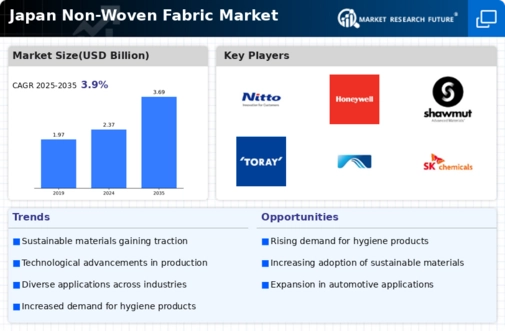The non woven fabric market in Japan is characterized by a dynamic competitive landscape, driven by innovation, sustainability, and strategic partnerships. Key players such as Toray Industries (Japan), Asahi Kasei Corporation (Japan), and Mitsubishi Chemical Corporation (Japan) are at the forefront, each adopting distinct strategies to enhance their market positioning. Toray Industries (Japan) focuses on advanced material development, emphasizing eco-friendly products, while Asahi Kasei Corporation (Japan) leverages its strong R&D capabilities to innovate in medical and hygiene applications. Mitsubishi Chemical Corporation (Japan) appears to be concentrating on expanding its production capacity to meet rising demand, particularly in the automotive and construction sectors. Collectively, these strategies contribute to a competitive environment that is increasingly oriented towards sustainability and technological advancement.
In terms of business tactics, companies are localizing manufacturing to reduce lead times and optimize supply chains. The market structure is moderately fragmented, with several players vying for market share, yet the influence of major companies remains substantial. This competitive structure allows for a diverse range of products and innovations, catering to various end-user industries, including healthcare, automotive, and consumer goods.
In November 2025, Toray Industries (Japan) announced the launch of a new line of biodegradable non woven fabrics aimed at the hygiene market. This strategic move not only aligns with global sustainability trends but also positions Toray as a leader in eco-friendly solutions, potentially attracting environmentally conscious consumers and businesses alike. The introduction of these products may enhance their competitive edge in a market increasingly focused on sustainability.
In October 2025, Asahi Kasei Corporation (Japan) expanded its partnership with a leading medical device manufacturer to develop advanced non woven materials for surgical applications. This collaboration underscores Asahi Kasei's commitment to innovation in the healthcare sector, suggesting that the company is strategically positioning itself to capitalize on the growing demand for high-performance medical materials. Such partnerships may enhance their product offerings and market reach.
In September 2025, Mitsubishi Chemical Corporation (Japan) unveiled plans to invest $50 million in expanding its non woven fabric production facilities in Japan. This investment is indicative of the company's strategy to bolster its manufacturing capabilities in response to increasing demand across various sectors. By enhancing production capacity, Mitsubishi Chemical aims to solidify its market presence and respond more effectively to customer needs.
As of December 2025, current trends in the non woven fabric market are heavily influenced by digitalization, sustainability, and the integration of AI technologies. Strategic alliances are becoming increasingly vital, as companies seek to leverage complementary strengths to enhance innovation and market responsiveness. The competitive differentiation is likely to evolve from traditional price-based competition towards a focus on technological advancements, product innovation, and supply chain reliability. This shift may redefine how companies position themselves in the market, emphasizing the importance of sustainable practices and cutting-edge technology.





















Leave a Comment